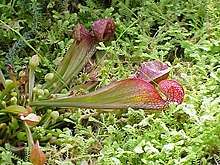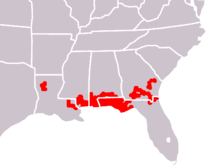Sarracenia psittacina
Sarracenia psittacina, also known as the parrot pitcherplant,[1] is a carnivorous plant in the genus Sarracenia. Like all the Sarracenia, it is native to North America, in the Southeastern United States.
| Parrot pitcher plant | |
|---|---|
 | |
| Scientific classification | |
| Kingdom: | Plantae |
| Clade: | Tracheophytes |
| Clade: | Angiosperms |
| Clade: | Eudicots |
| Clade: | Asterids |
| Order: | Ericales |
| Family: | Sarraceniaceae |
| Genus: | Sarracenia |
| Species: | S. psittacina |
| Binomial name | |
| Sarracenia psittacina Michx. (1803) | |
 | |
| Sarracenia psittacina range | |
| Synonyms | |
| |
Sarracenia psittacina employs the same trapping mechanism as Darlingtonia californica, using a small entrance in the pitcher mouth, which prey goes through in search of more nectar that was produced by the plant on the rim of the pitcher mouth. The prey is then confused by light shining through what appear to be false exits (or "windows") and crawls toward the brighter area down into the pitcher. Criss-crossed downward-facing hairs densely line the interior of the pitcher, forcing the prey further into the pitcher to an area where digestive enzymes such as proteases are prevalent in the liquid.
This species is frequently submerged in its native habitat and will capture water arthropods and tadpoles, for example, while submerged.[2][3]
Infraspecific taxa
- Sarracenia psittacina f. heterophylla J. & J.Ainsworth (1996) nom.nud.
- Sarracenia psittacina var. minor Hook. (1834)
 Sarracenia psittacina flower
Sarracenia psittacina flower Sarracenia psittacina
Sarracenia psittacina Sarracenia psittacina
Sarracenia psittacina
References
- "Sarracenia psittacina". Natural Resources Conservation Service PLANTS Database. USDA. Retrieved 6 November 2015.
- D'Amato, Peter. 1998. The Savage Garden: Cultivating Carnivorous Plants. Ten Speed Press, Berkeley. ISBN 0-89815-915-6
- Schnell, Donald E. 2002. Carnivorous Plants of the United States and Canada, Second Edition. Timber Press: Portland, Oregon.
